Acura RDX 2013 Owner's Manual
Manufacturer: ACURA, Model Year: 2013, Model line: RDX, Model: Acura RDX 2013Pages: 364, PDF Size: 12.54 MB
Page 331 of 364
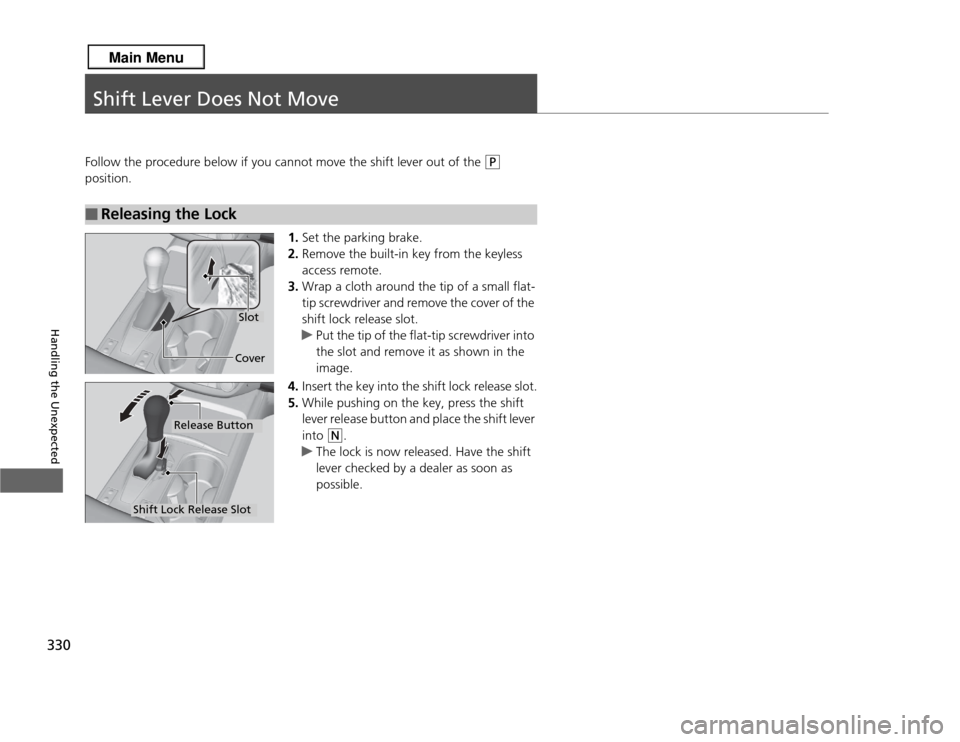
330Handling the Unexpected
Shift Lever Does Not MoveFollow the procedure below if you cannot move the shift lever out of the
(P
position.
1.Set the parking brake.
2. Remove the built-in key from the keyless
access remote.
3. Wrap a cloth around the tip of a small flat-
tip screwdriver and remove the cover of the
shift lock release slot.
u Put the tip of the flat-tip screwdriver into
the slot and remove it as shown in the
image.
4. Insert the key into the shift lock release slot.
5. While pushing on the key, press the shift
lever release button and place the shift lever
into
(N
.
u The lock is now released. Have the shift
lever checked by a dealer as soon as
possible.
■
Releasing the Lock
Slot
Cover
Release Button
Shift Lock Release Slot
Page 332 of 364
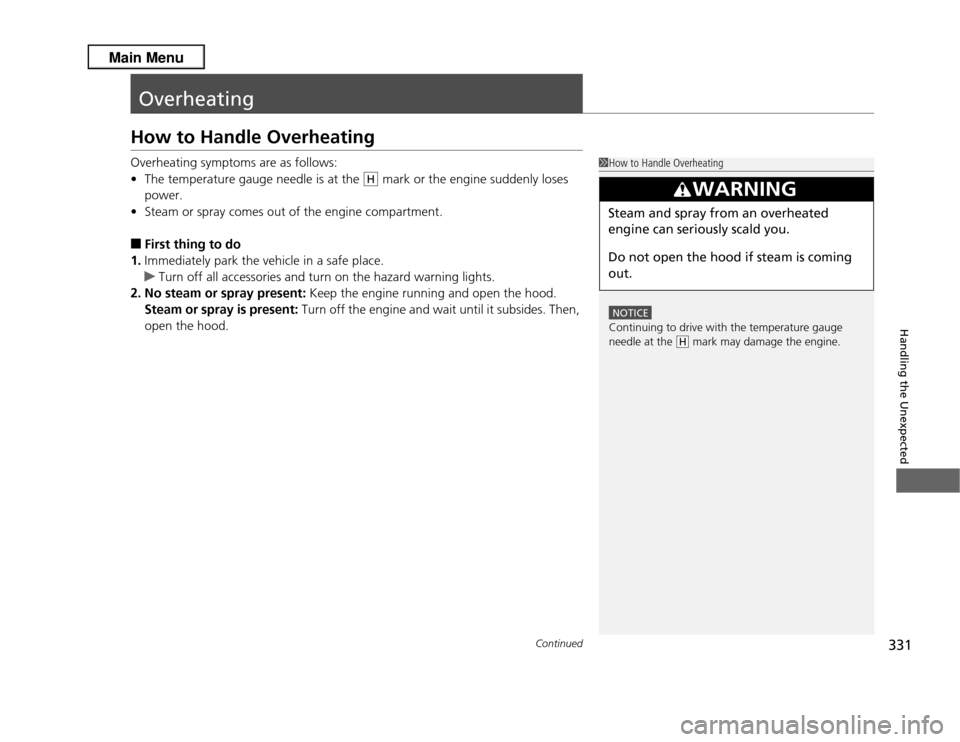
331
Continued
Handling the Unexpected
OverheatingHow to Handle OverheatingOverheating symptoms are as follows:
•The temperature gauge needle is at the mark or the engine suddenly loses
power.
• Steam or spray comes out of the engine compartment.■
First thing to do
1. Immediately park the vehicle in a safe place.
u Turn off all accessories and turn on the hazard warning lights.
2. No steam or spray present: Keep the engine running and open the hood.
Steam or spray is present: Turn off the engine and wait until it subsides. Then,
open the hood.
1 How to Handle Overheating
NOTICEContinuing to drive with the temperature gauge
needle at the mark may damage the engine.
3
WARNING
Steam and spray from an overheated
engine can seriously scald you.
Do not open the hood if steam is coming
out.
H
H
Page 333 of 364
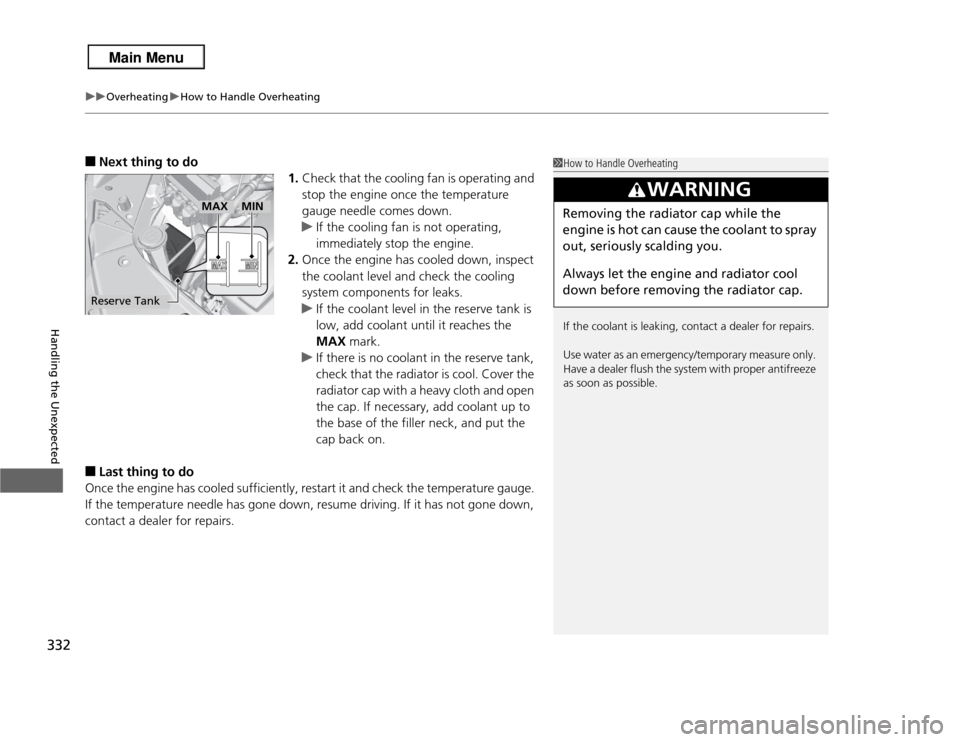
uuOverheating uHow to Handle Overheating
332Handling the Unexpected
■
Next thing to do
1.Check that the cooling fan is operating and
stop the engine once the temperature
gauge needle comes down.
u If the cooling fan is not operating,
immediately stop the engine.
2. Once the engine has cooled down, inspect
the coolant level and check the cooling
system components for leaks.
u If the coolant level in the reserve tank is
low, add coolant until it reaches the
MAX mark.
u If there is no coolant in the reserve tank,
check that the radiator is cool. Cover the
radiator cap with a heavy cloth and open
the cap. If necessary, add coolant up to
the base of the filler neck, and put the
cap back on.
■
Last thing to do
Once the engine has cooled sufficiently, restart it and check the temperature gauge.
If the temperature needle has gone down, resume driving. If it has not gone down,
contact a dealer for repairs.
1 How to Handle Overheating
If the coolant is leaking, contact a dealer for repairs.
Use water as an emergency/temporary measure only.
Have a dealer flush the system with proper antifreeze
as soon as possible.
3
WARNING
Removing the radiator cap while the
engine is hot can cause the coolant to spray
out, seriously scalding you.
Always let the engine and radiator cool
down before removing the radiator cap.
Reserve Tank
MAX
MIN
Page 334 of 364
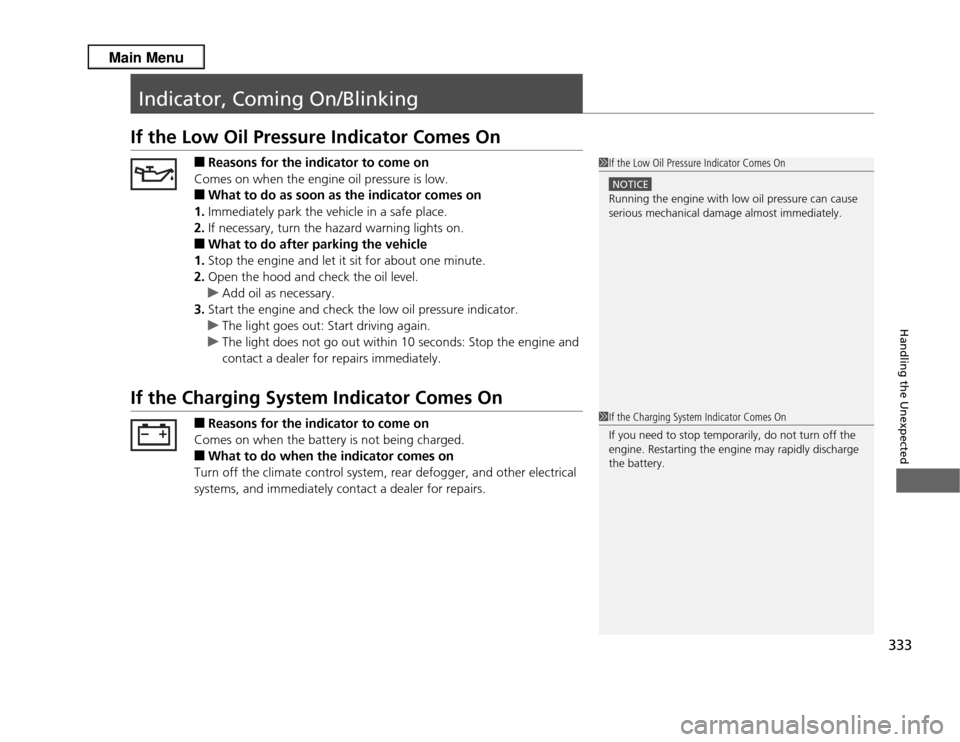
333Handling the Unexpected
Indicator, Coming On/BlinkingIf the Low Oil Pressure Indicator Comes On
■
Reasons for the indicator to come on
Comes on when the engine oil pressure is low.
■
What to do as soon as the indicator comes on
1. Immediately park the vehicle in a safe place.
2. If necessary, turn the hazard warning lights on.
■
What to do after parking the vehicle
1. Stop the engine and let it sit for about one minute.
2. Open the hood and check the oil level.
u Add oil as necessary.
3. Start the engine and check the low oil pressure indicator.
u The light goes out: Start driving again.
u The light does not go out within 10 seconds: Stop the engine and
contact a dealer for repairs immediately.
If the Charging System Indicator Comes On
■
Reasons for the indicator to come on
Comes on when the battery is not being charged.
■
What to do when the indicator comes on
Turn off the climate control system, rear defogger, and other electrical
systems, and immediately contact a dealer for repairs.
1 If the Low Oil Pressure Indicator Comes On
NOTICERunning the engine with low oil pressure can cause
serious mechanical damage almost immediately.1If the Charging System Indicator Comes On
If you need to stop temporarily, do not turn off the
engine. Restarting the engine may rapidly discharge
the battery.
Page 335 of 364
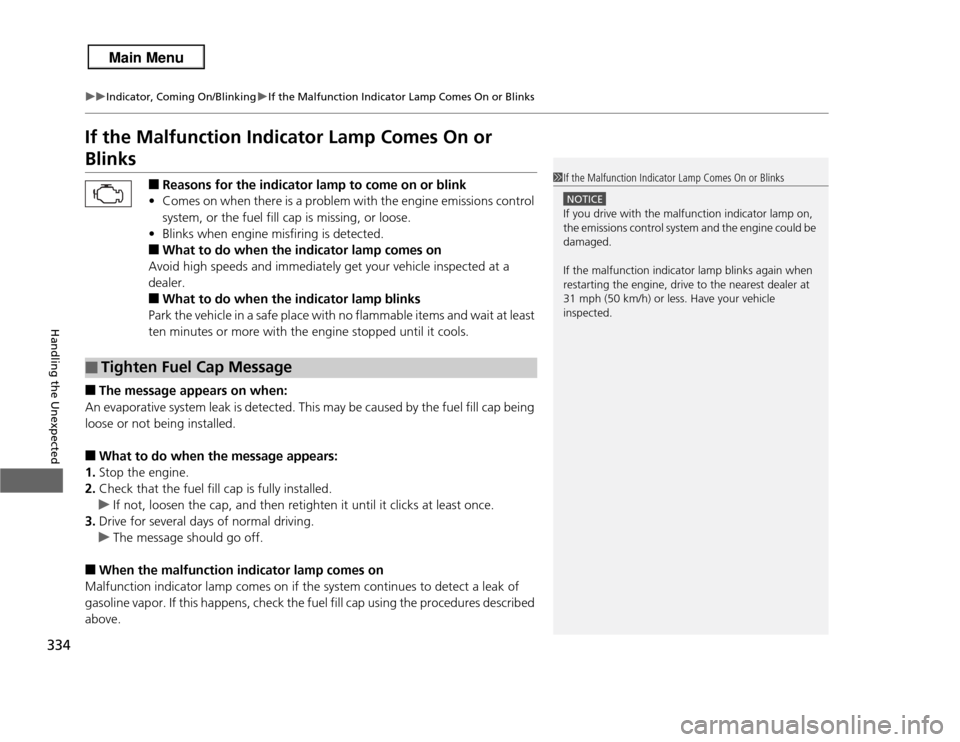
334
uuIndicator, Coming On/Blinking uIf the Malfunction Indicator Lamp Comes On or Blinks
Handling the Unexpected
If the Malfunction Indicator Lamp Comes On or Blinks
■
Reasons for the indicator lamp to come on or blink
• Comes on when there is a problem with the engine emissions control
system, or the fuel fill cap is missing, or loose.
• Blinks when engine misfiring is detected.
■
What to do when the indicator lamp comes on
Avoid high speeds and immediately get your vehicle inspected at a
dealer.
■
What to do when the indicator lamp blinks
Park the vehicle in a safe place with no flammable items and wait at least
ten minutes or more with the engine stopped until it cools.
■
The message appears on when:
An evaporative system leak is detected. This may be caused by the fuel fill cap being
loose or not being installed.
■
What to do when the message appears:
1. Stop the engine.
2. Check that the fuel fill cap is fully installed.
u If not, loosen the cap, and then retighten it until it clicks at least once.
3. Drive for several days of normal driving.
u The message should go off.
■
When the malfunction indicator lamp comes on
Malfunction indicator lamp comes on if the system continues to detect a leak of
gasoline vapor. If this happens, check the fuel fill cap using the procedures described
above.
■
Tighten Fuel Cap Message
1 If the Malfunction Indicator Lamp Comes On or Blinks
NOTICEIf you drive with the malfunction indicator lamp on,
the emissions control system and the engine could be
damaged.
If the malfunction indicator lamp blinks again when
restarting the engine, drive to the nearest dealer at
31 mph (50 km/h) or less. Have your vehicle
inspected.
Page 336 of 364
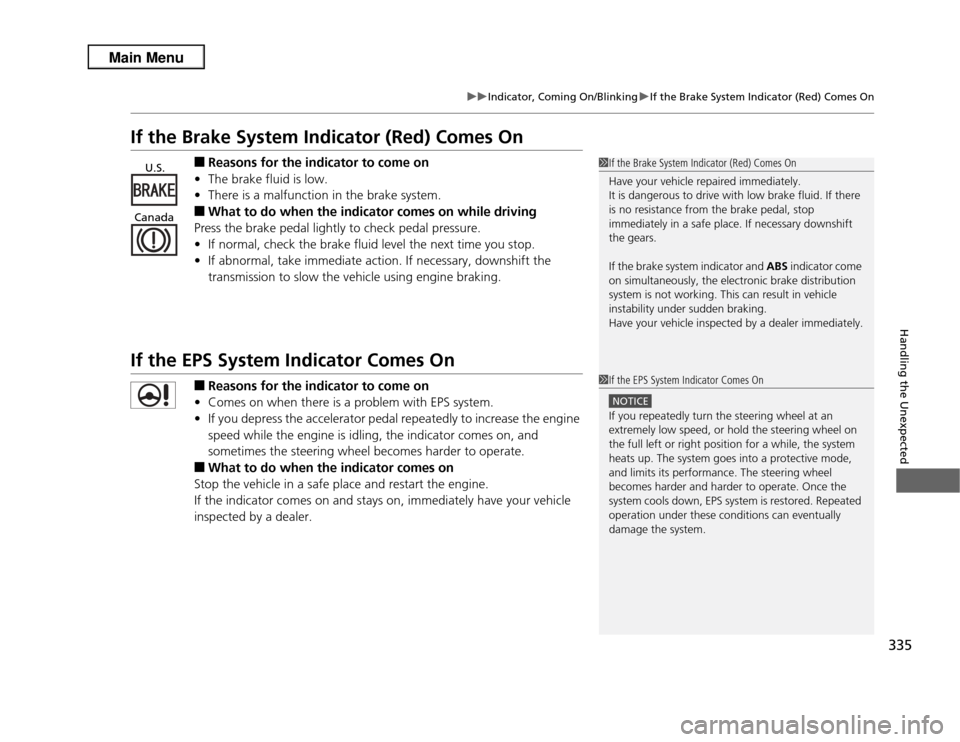
335
uuIndicator, Coming On/Blinking uIf the Brake System Indicator (Red) Comes On
Handling the Unexpected
If the Brake System Indicator (Red) Comes On
■
Reasons for the indicator to come on
• The brake fluid is low.
• There is a malfunction in the brake system.
■
What to do when the indicator comes on while driving
Press the brake pedal lightly to check pedal pressure.
• If normal, check the brake fluid level the next time you stop.
• If abnormal, take immediate action. If necessary, downshift the
transmission to slow the vehicle using engine braking.
If the EPS System Indicator Comes On
■
Reasons for the indicator to come on
• Comes on when there is a problem with EPS system.
• If you depress the accelerator pedal repeatedly to increase the engine
speed while the engine is idling, the indicator comes on, and
sometimes the steering wheel becomes harder to operate.
■
What to do when the indicator comes on
Stop the vehicle in a safe place and restart the engine.
If the indicator comes on and stays on, immediately have your vehicle
inspected by a dealer.
1 If the Brake System Indicator (Red) Comes On
Have your vehicle repaired immediately.
It is dangerous to drive with low brake fluid. If there
is no resistance from the brake pedal, stop
immediately in a safe place. If necessary downshift
the gears.
If the brake system indicator and ABS indicator come
on simultaneously, the electronic brake distribution
system is not working. This can result in vehicle
instability under sudden braking.
Have your vehicle inspected by a dealer immediately.
U.S.
Canada
1 If the EPS System Indicator Comes On
NOTICEIf you repeatedly turn the steering wheel at an
extremely low speed, or hold the steering wheel on
the full left or right position for a while, the system
heats up. The system goes into a protective mode,
and limits its performance. The steering wheel
becomes harder and harder to operate. Once the
system cools down, EPS system is restored. Repeated
operation under these conditions can eventually
damage the system.
Page 337 of 364
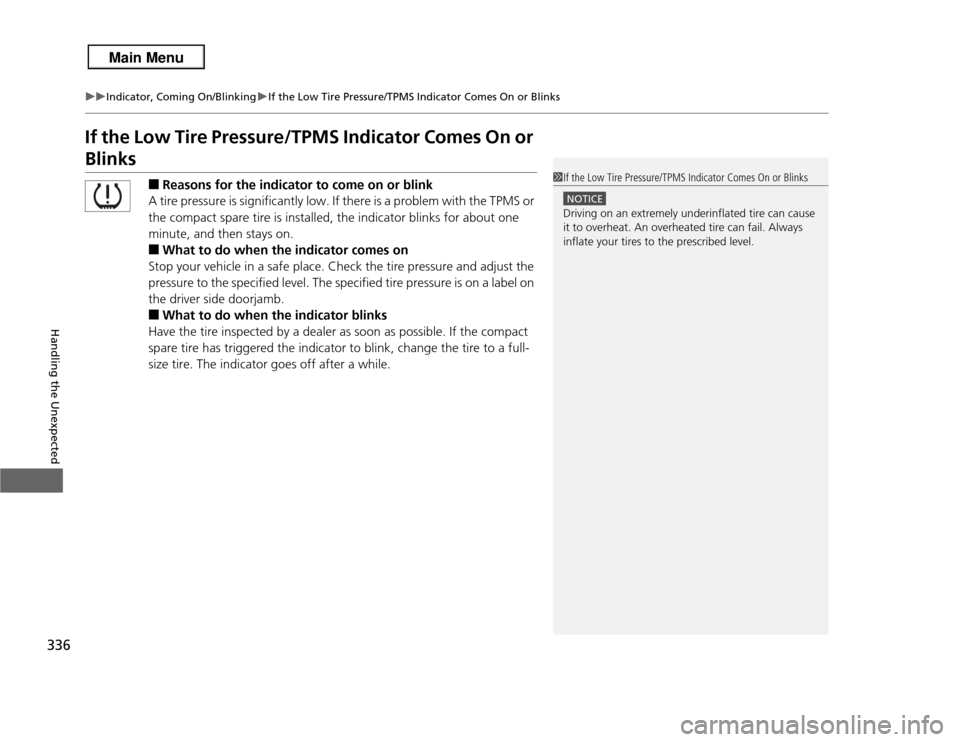
336
uuIndicator, Coming On/Blinking uIf the Low Tire Pressure/TPMS Indicator Comes On or Blinks
Handling the Unexpected
If the Low Tire Pressure/TPMS Indicator Comes On or Blinks
■
Reasons for the indicator to come on or blink
A tire pressure is significantly low. If there is a problem with the TPMS or
the compact spare tire is installed, the indicator blinks for about one
minute, and then stays on.
■
What to do when the indicator comes on
Stop your vehicle in a safe place. Check the tire pressure and adjust the
pressure to the specified level. The specified tire pressure is on a label on
the driver side doorjamb.
■
What to do when the indicator blinks
Have the tire inspected by a dealer as soon as possible. If the compact
spare tire has triggered the indicator to blink, change the tire to a full-
size tire. The indicator goes off after a while.
1 If the Low Tire Pressure/TPMS Indicator Comes On or Blinks
NOTICEDriving on an extremely underinflated tire can cause
it to overheat. An overheated tire can fail. Always
inflate your tires to the prescribed level.
Page 338 of 364
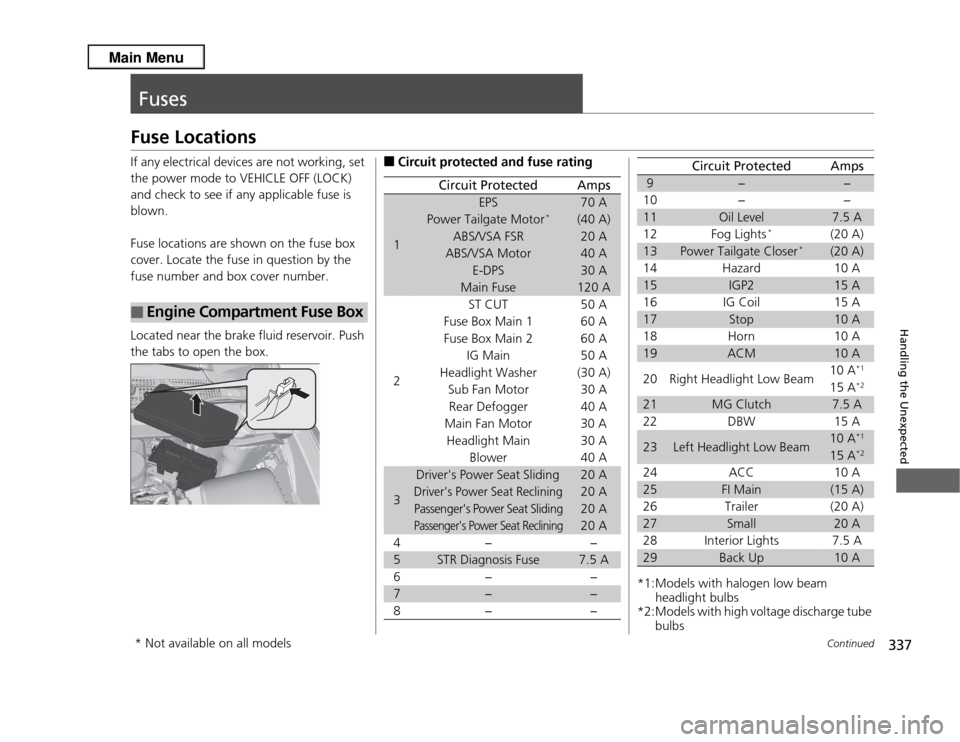
337
Continued
Handling the Unexpected
FusesFuse LocationsIf any electrical devices are not working, set
the power mode to VEHICLE OFF (LOCK)
and check to see if any applicable fuse is
blown.
Fuse locations are shown on the fuse box
cover. Locate the fuse in question by the
fuse number and box cover number.
Located near the brake fluid reservoir. Push
the tabs to open the box.■
Engine Compartment Fuse Box
■
Circuit protected and fuse rating
Circuit Protected
Amps
1
EPS
70 A
Power Tailgate Motor
*
(40 A)
ABS/VSA FSR
20 A
ABS/VSA Motor
40 A
E-DPS
30 A
Main Fuse
120 A
2
ST CUT
50 A
Fuse Box Main 1 60 A
Fuse Box Main 2
60 A
IG Main 50 A
Headlight Washer
(30 A)
Sub Fan Motor 30 A Rear Defogger 40 A
Main Fan Motor 30 A Headlight Main 30 A Blower 40 A
3
Driver's Power Seat Sliding
20 A
Driver's Power Seat Reclining
20 A
Passenger's Power Seat Sliding
20 A
Passenger's Power Seat Reclining
20 A
4− −
5
STR Diagnosis Fuse
7.5 A
6− −
7
−
−
8− −
*1:Models with halogen low beam headlight bulbs
*2:Models with high voltage discharge tube
bulbs9
−
−
10 − −
11
Oil Level
7.5 A
12 Fog Lights
*
(20 A)
13
Power Tailgate Closer
*
(20 A)
14 Hazard 10 A
15
IGP2
15 A
16 IG Coil 15 A
17
Stop
10 A
18 Horn 10 A
19
ACM
10 A
20 Right Headlight Low Beam 10 A
*1
15 A
*2
21
MG Clutch
7.5 A
22 DBW 15 A
23
Left Headlight Low Beam
10 A
*1
15 A
*2
24ACC 10 A25
FI Main
(15 A)
26 Trailer (20 A)
27
Small
20 A
28 Interior Lights 7.5 A
29
Back Up
10 A
Circuit Protected
Amps
* Not available on all models
Page 339 of 364
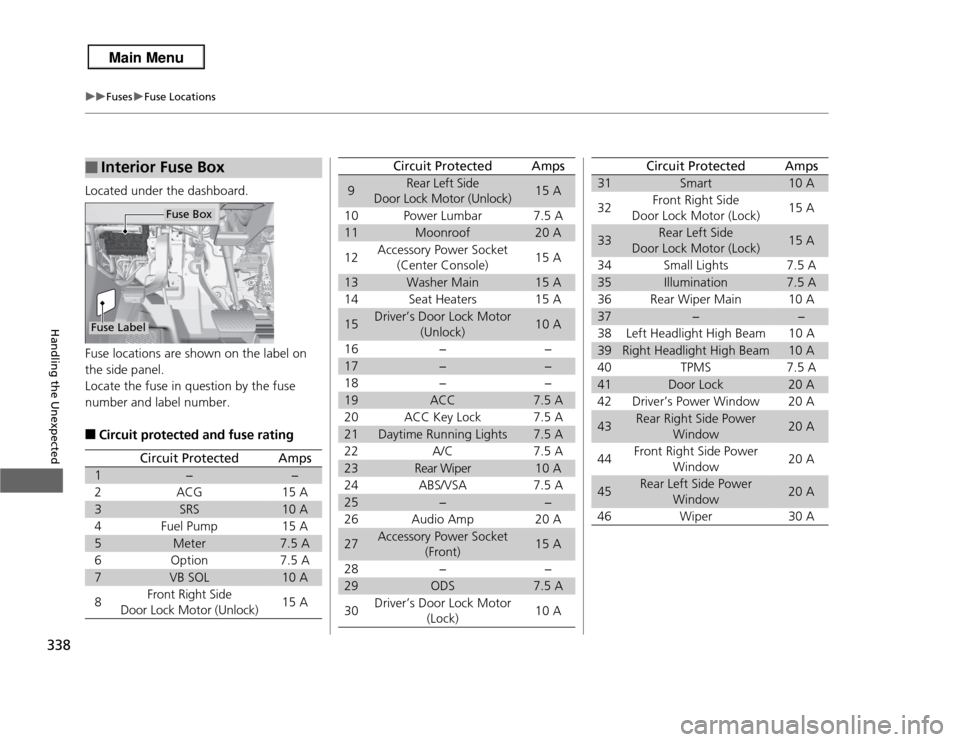
338
uuFuses uFuse Locations
Handling the Unexpected
Located under the dashboard.
Fuse locations are shown on the label on
the side panel.
Locate the fuse in question by the fuse
number and label number.■
Circuit protected and fuse rating
■
Interior Fuse BoxFuse Label
Fuse Box
Circuit Protected
Amps
1
−
−
2
ACG
15 A
3
SRS
10 A
4
Fuel Pump
15 A
5
Meter
7.5 A
6
Option
7.5 A
7
VB SOL
10 A
8
Front Right Side
Door Lock Motor (Unlock)
15 A
9
Rear Left Side
Door Lock Motor (Unlock)
15 A
10 Power Lumbar 7.5 A
11
Moonroof
20 A
12 Accessory Power Socket
(Center Console) 15 A
13
Washer Main
15 A
14 Seat Heaters 15 A
15
Driver’s Door Lock Motor (Unlock)
10 A
16 − −
17
−
−
18 − −
19
ACC
7.5 A
20 ACC Key Lock 7.5 A
21
Daytime Running Lights
7.5 A
22 A/C 7.5 A
23
Rear Wiper
10 A
24 ABS/VSA 7.5 A
25
−
−
26 Audio Amp 20 A
27
Accessory Power Socket (Front)
15 A
28 − −
29
ODS
7.5 A
30 Driver’s Door Lock Motor
(Lock) 10 A
Circuit Protected
Amps
31
Smart
10 A
32 Front Right Side
Door Lock Motor (Lock) 15 A
33
Rear Left Side
Door Lock Motor (Lock)
15 A
34 Small Lights 7.5 A
35
Illumination
7.5 A
36 Rear Wiper Main 10 A
37
−
−
38 Left Headlight High Beam 10 A
39
Right Headlight High Beam
10 A
40 TPMS 7.5 A
41
Door Lock
20 A
42 Driver’s Power Window 20 A
43
Rear Right Side Power Window
20 A
44 Front Right Side Power
Window 20 A
45
Rear Left Side Power
Window
20 A
46 Wiper 30 A
Circuit Protected
Amps
Page 340 of 364
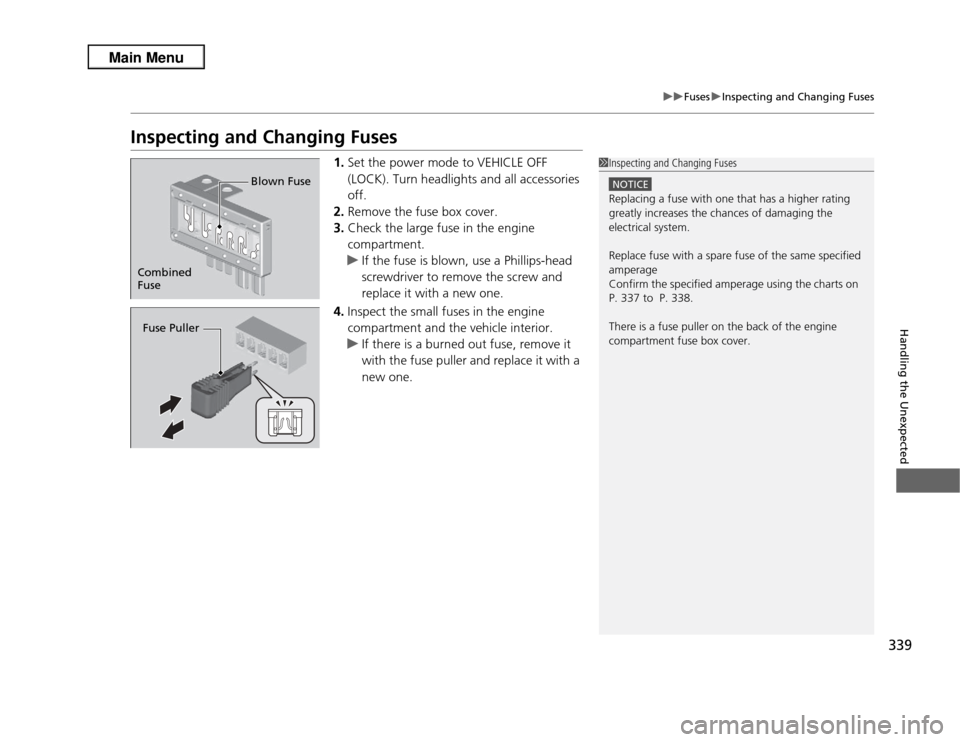
339
uuFuses uInspecting and Changing Fuses
Handling the Unexpected
Inspecting and Changing Fuses
1. Set the power mode to VEHICLE OFF
(LOCK). Turn headlights and all accessories
off.
2. Remove the fuse box cover.
3. Check the large fuse in the engine
compartment.
u If the fuse is blown, use a Phillips-head
screwdriver to remove the screw and
replace it with a new one.
4. Inspect the small fuses in the engine
compartment and the vehicle interior.
u If there is a burned out fuse, remove it
with the fuse puller and replace it with a
new one.
1Inspecting and Changing Fuses
NOTICEReplacing a fuse with one that has a higher rating
greatly increases the chances of damaging the
electrical system.
Replace fuse with a spare fuse of the same specified
amperage
Confirm the specified amperage using the charts on
P. 337 to P. 338.
There is a fuse puller on the back of the engine
compartment fuse box cover.
Combined
Fuse Blown FuseFuse Puller